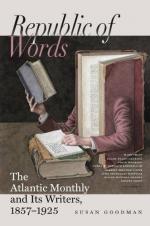The Abbey church is now only a ruin, but the airy span of its rich Gothic window remains, as evidence of its original beauty. Through the now vacant space, once the wide door of entrance, we saw the floor of green grass, and in the centre the monument to Byron’s favorite dog, Bowswain. All was silent about the ruin, except the cawing of a thousand rooks, who were settling themselves for the night with a vast amount of noise and bustle on the high branches of the old trees which sweep down on one side of the Abbey.
The residence which adjoins the church, once a monastery, was inherited by Lord Byron, with the title: to part with it was a dire necessity. Colonel Wildman, the school-fellow of Byron at Harrow, purchased the estate from the unhappy poet in the most liberal and generous manner, and blessed it into a home. On entering the house, we were shown through long corridors and vaulted passages, in which the monastic character of the building was preserved. When Byron came to Newstead from college, the Abbey was in a most dilapidated condition, and he had only means enough to make a few rooms habitable for himself and his mother. A gloomy and desolate abode it must have been. The furniture of Byron’s bedroom remains as it stood when removed from Cambridge. On the walls are prints of his school at Harrow, and Trinity College, with various relics and boyish treasures. The window commands a view of the sheet of water which stretches before the Abbey, with its wooded banks,—a scene which he loves and remembers even when “Lake Leman wooes him with her crystal face,” for he writes to his sister,—
“It doth remind me of our own dear
lake
By the old hall, which shall be
mine no more.”
Adjoining Byron’s room is a suite of apartments, ruinous and roofless in his day, but which Colonel Wildman has restored, and furnished most appropriately with old tapestry and antique tables and chairs. These rooms wear a ghostly aspect, and we were not surprised to learn that one, at least, had the reputation of being haunted. The great drawing-room, once the dormitory of the monks, is now a splendid apartment richly decorated; above the chimney is a fine portrait of Lord Byron, and in an ancient cabinet was shown the cup made from a skull found in one of the stone coffins near the Abbey church. It is mounted in silver, and the well-known lines, written by Byron, are engraved on the rim. “Having it made” was, as he said himself, “one of his foolish freaks, of which he was ashamed.” The cup, however, bears little resemblance to a skull. Colonel Wildman preserved the furniture of Byron’s dining-room, and other apartments, (very simple it is,) without alteration, in the hope that he might return from Greece and revisit the halls of his fathers. Had Fate so willed, he would have found how kindly and faithfully his early friend had associated him with Newstead, and preserved every memorial of past history connected with the place. Yet thoughts of bitterness would even then have mingled with these familiar scenes, for it was not the heir of the Byrons who had restored Newstead Abbey to beauty and order.




